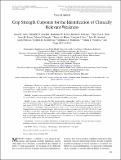| dc.contributor.author | Alley, Dawn E. | en_US |
| dc.contributor.author | Shardell, Michelle D. | en_US |
| dc.contributor.author | Peters, Katherine W. | en_US |
| dc.contributor.author | McLean, Robert R. | en_US |
| dc.contributor.author | Dam, Thuy-Tien L. | en_US |
| dc.contributor.author | Kenny, Anne M. | en_US |
| dc.contributor.author | Fragala, Maren S. | en_US |
| dc.contributor.author | Harris, Tamara B. | en_US |
| dc.contributor.author | Kiel, Douglas P. | en_US |
| dc.contributor.author | Guralnik, Jack M. | en_US |
| dc.contributor.author | Ferrucci, Luigi | en_US |
| dc.contributor.author | Kritchevsky, Stephen B. | en_US |
| dc.contributor.author | Studenski, Stephanie A. | en_US |
| dc.contributor.author | Vassileva, Maria T. | en_US |
| dc.contributor.author | Cawthon, Peggy M. | en_US |
| dc.date.accessioned | 2014-05-06T16:18:06Z | |
| dc.date.issued | 2014 | en_US |
| dc.identifier.citation | Alley, D. E., M. D. Shardell, K. W. Peters, R. R. McLean, T. L. Dam, A. M. Kenny, M. S. Fragala, et al. 2014. “Grip Strength Cutpoints for the Identification of Clinically Relevant Weakness.” The Journals of Gerontology Series A: Biological Sciences and Medical Sciences 69 (5): 559-566. doi:10.1093/gerona/glu011. http://dx.doi.org/10.1093/gerona/glu011. | en |
| dc.identifier.issn | 1079-5006 | en |
| dc.identifier.uri | http://nrs.harvard.edu/urn-3:HUL.InstRepos:12152971 | |
| dc.description.abstract | Background. Weakness is common and contributes to disability, but no consensus exists regarding a strength cutpoint to identify persons at high risk. This analysis, conducted as part of the Foundation for the National Institutes of Health Sarcopenia Project, sought to identify cutpoints that distinguish weakness associated with mobility impairment, defined as gait speed less than 0.8 m/s. Methods. In pooled cross-sectional data (9,897 men and 10,950 women), Classification and Regression Tree analysis was used to derive cutpoints for grip strength associated with mobility impairment. Results. In men, a grip strength of 26–32 kg was classified as “intermediate” and less than 26 kg as “weak”; 11% of men were intermediate and 5% were weak. Compared with men with normal strength, odds ratios for mobility impairment were 3.63 (95% CI: 3.01–4.38) and 7.62 (95% CI 6.13–9.49), respectively. In women, a grip strength of 16–20 kg was classified as “intermediate” and less than 16 kg as “weak”; 25% of women were intermediate and 18% were weak. Compared with women with normal strength, odds ratios for mobility impairment were 2.44 (95% CI 2.20–2.71) and 4.42 (95% CI 3.94–4.97), respectively. Weakness based on these cutpoints was associated with mobility impairment across subgroups based on age, body mass index, height, and disease status. Notably, in women, grip strength divided by body mass index provided better fit relative to grip strength alone, but fit was not sufficiently improved to merit different measures by gender and use of a more complex measure. Conclusions. Cutpoints for weakness derived from this large, diverse sample of older adults may be useful to identify populations who may benefit from interventions to improve muscle strength and function. | en |
| dc.language.iso | en_US | en |
| dc.publisher | Oxford University Press | en |
| dc.relation.isversionof | doi:10.1093/gerona/glu011 | en |
| dc.relation.hasversion | http://www.ncbi.nlm.nih.gov/pmc/articles/PMC3991145/pdf/ | en |
| dash.license | LAA | en_US |
| dc.subject | Muscle | en |
| dc.subject | Sarcopenia | en |
| dc.subject | Grip strength | en |
| dc.subject | Physical function | en |
| dc.subject | Gait speed. | en |
| dc.title | Grip Strength Cutpoints for the Identification of Clinically Relevant Weakness | en |
| dc.type | Journal Article | en_US |
| dc.description.version | Version of Record | en |
| dc.relation.journal | The Journals of Gerontology Series A: Biological Sciences and Medical Sciences | en |
| dash.depositing.author | McLean, Robert R. | en_US |
| dc.date.available | 2014-05-06T16:18:06Z | |
| dc.identifier.doi | 10.1093/gerona/glu011 | * |
| dash.authorsordered | false | |
| dash.contributor.affiliated | McLean, Robert | |
| dash.contributor.affiliated | Kiel, Douglas | |


